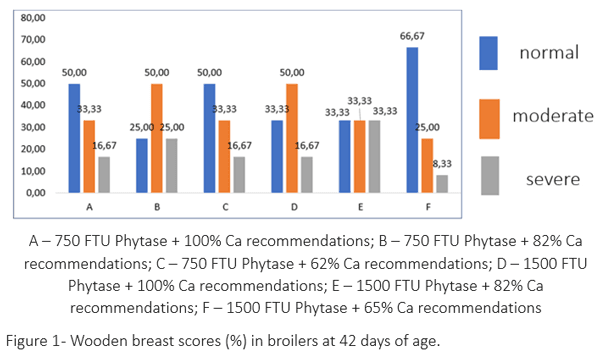Occurrence of wooden breast in broilers fed diets with reduction of calcium levels and two doses of phytase
Published: June 4, 2020
By: Miliane Alves da Costa 1; Pedro Moraes Rezende 1; Alexandre Barbosa de Brito 2; Marcos Barcellos Cafe 1; Jose Henrique Stringhini 1,3. / 1 Departamento de Zootecnia, Escola de Veterinária e Zootecnia, Universidade Federal de Goias (EVZ/UFG, Brazil); 2 ABVista LATAM; 3 CNPq Researcher.
Summary
Key Words: broiler carcass, enzyme, meat quality, nutritional programs
Introduction
Calcium reduction and phytase supplementation were considered an important combination in broiler nutrition. Wooden breast (WB) has been considered one of the most important challenges in the Poultry Industry in the 21st century. The superdosing of phytase can affect metabolic functions in the early life of broilers, and the studies with the interaction of this enzyme with calcium, phosphorus and carcass evaluation must be incremented.
Based on this, calcium reduction and phytase supplementation effect on the occurrence of WB in broilers at 42 days of age was evaluated.
Materials and Methods
The experiment was conducted in the experimental avian facilities of EVZ/UFG, Goiania, Brazil, with 864 Cobb500 male chicks allotted in a completely randomized design and factorial arrangement 2x3, 6 treatments and 8 replications of 18 birds each.
Birds were fed corn soybean meal and corn gluten meal diets with 3 levels of calcium, 100% of Brazilian Tables recommendations, and reduction of 18 and 36% (1.011; 0.907; 0.828 e 0.661% of calcium for phase pre-starter, starter, growth and finishing, respectively). Phytase matrix was considered to release phosphorus to 750FTU, and for 1500FTU, the level above 750 FTU was considered on top.
On the 42nd day, 12 birds per treatment were slaughtered, totalling 72, and WB occurrence was evaluated according to 3 scores:
0 - normal
1 - moderate
2 - severe.
Data were analysed with Kruskal-Wallis and Bonferroni tests (5%).
Results
No diferences were observed for WB occurence, but when phytase levels were considered separately, the score 0 was 52,28% and 47,22%, score 1, 38,89% and 36,11% and score 2, 8,33% and 16,67% for 750 and 1500 FTU, respectively. For calcium levels, the score 0 was 66,67%, 41,67% and 41,67%, score 1, 29,17%, 41,67% and 41,67%, and score 2, 4,17%, 16,67 and 16,67% for 64%, 82% and 100% of calcium levels recommended by Brazilian tables, respectively. The medians were not statistically different when effects of calcium and phytase were considered separately or in the interaction.
Conclusion
The reduction of calcium levels were not effective to reduce the WB occurence, even when 750 or 1500 FTU of phytase is used.

Published in the Proceedings of the 2019 International Poultry Scientific Forum, p. 101, abstract P330. Presented at IPPE 2019.
Content from the event:
Related topics:
Authors:
AB Vista
Universidade Federal de Goiás - UFG
Recommend
Comment
Share

Would you like to discuss another topic? Create a new post to engage with experts in the community.










.jpg&w=3840&q=75)